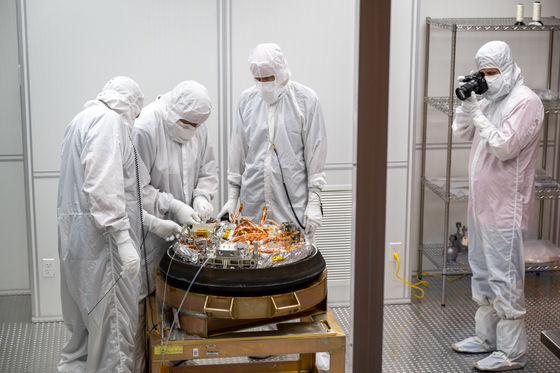NASA's Osiris-Rex probe successfully returns samples from the asteroid Bennu, revealing the origin of life on Earth and the formation of the solar system

NASA's space probe 'OSIRIS-REx', also known as the 'American version
NASA's First Asteroid Sample Has Landed, Now Secure in Clean Room | NASA
https://www.nasa.gov/press-release/nasa-s-first-asteroid-sample-has-landed-now-secure-in-clean-room
NASA's OSIRIS-REx lands samples of asteroid Bennu on Earth in historic first | Space
https://www.space.com/nasa-osiris-rex-success-recovery-asteroid-sample
NASA's first asteroid samples land on Earth after release from spacecraft
https://phys.org/news/2023-09-nasa-asteroid-samples-earth-spacecraft.html
TOUCHDOWN! NASA Just Returned to Earth With The Largest Asteroid Samples Ever : ScienceAlert
https://www.sciencealert.com/touchdown-nasa-just-returned-to-earth-with-the-largest-asteroid-samples-ever
NASA's official X account posted on September 24th, ``Touchdown! 'We landed at the Utah Test and Training Range at 23:52 (23:52),' announcing the sample's arrival on Earth.
TOUCHDOWN! The #OSIRISREx sample capsule landed at the Utah Test and Training Range at 10:52am ET (1452 UTC) after a 3.86-billion mile journey. This marks the US's first sample return mission of its kind and will open a time capsule to the beginnings of our solar system. pic.twitter.com/N8fun14Plt
— NASA (@NASA) September 24, 2023
OSIRIS-REx was launched on September 8, 2016, arrived at the asteroid Bennu on December 3, 2018, and after exploring sample collection sites from 2019 to 2020, it was launched on October 20, 2020. Samples were collected. It will then begin its return journey to Earth on May 10, 2021.
The capsule dropped from OSIRIS-REx to Earth was undamaged, and the asteroid samples that tell us what the universe looked like 4.5 billion years ago were also uncontaminated.
It's a story 4.5-billion years in the making. See what's next for the asteroid samples returned today by #OSIRISREx .
— NASA (@NASA) September 24, 2023
Post-landing news briefing: https://t.co/Tik2R4kU8t
Mission blog: https://t.co/Kb5TMjeMQ9 pic.twitter.com/Xq2uRLyl9e
The capsule recovered from the Utah desert was taken to a temporary clean room, where it underwent a nitrogen purge , which involves blowing in nitrogen, an inert gas, to preserve the sample.
Your package has been delivered.
— NASA (@NASA) September 24, 2023
The #OSIRISREx sample return capsule containing rock and dust collected in space from asteroid Bennu has arrived at temporary clean room in Utah. The 4.5-billion-year-old sample will soon head to @NASA_Johnson for curation and analysis. pic.twitter.com /Ke0PcDAKt0
Samples collected from the asteroid Bennu will help scientists around the world better understand the formation of planets, the origin of the organic matter and water that fueled life on Earth, and the potential future dangers to Earth. It is expected that humanity will benefit from learning about asteroids that may affect humans.
'I congratulate the OSIRIS-REx team on their picture-perfect mission as America's first asteroid sample return, which will provide new insights into the origin and formation of our solar system,' said NASA Administrator Bill Nelson. What's more, Bennu is a potentially dangerous asteroid, so what we can learn from the sample will give us a better understanding of the types of asteroids that could come towards us. It will also be useful.'
The samples will now be sent to the Johnson Space Center in Houston for further research, with initial results expected to be announced at a press conference on October 11th. Most of the samples will be stored for future research, about a quarter will be used immediately for experiments, and a small amount will be sent to mission partners Japan and Canada.

This is the third sample return by OSIRIS-REx in the world, following the Japanese spacecraft Hayabusa and Hayabusa 2. The sample recovered from Bennu is estimated to weigh 250g, which is more abundant than the small sample brought back by Hayabusa in 2010 and the approximately 5.4g sample brought back by Hayabusa2 in 2020. , is attracting attention as it will enable more tests.
'The sample return is truly historic. This will be the largest sample we have brought back since the Apollo moon rocks,' NASA scientist Amy Simon told the media. did.
Bennu, which is about 500 meters in diameter, is made up of materials from the solar system that date back about 4.5 billion years. Samples recovered from Bennu contain water molecules trapped in carbon and minerals, the building blocks of life on Earth. It is believed that this includes.

It is also estimated that Bennu, which orbits the sun at a distance of about 81 million km from Earth, will reach its closest approach to Earth in 2182, and that there is a chance of it colliding with Earth, although the probability is approximately 1 in 2,700. The data provided by OSIRIS-REx will also be useful in research to avoid asteroid collisions.
In 2022, NASA conducted a DART mission that deflected a spacecraft by hitting an asteroid, successfully influencing the movement of Dimorphos , a satellite of a near-Earth asteroid.
A forum related to this article has been set up on the GIGAZINE official Discord server. Anyone can write freely, so please feel free to comment!
• Discord | 'What kind of discoveries can we expect from the asteroid samples collected by NASA?' | GIGAZINE
https://discord.com/channels/1037961069903216680/1155796646030999602
Related Posts:







